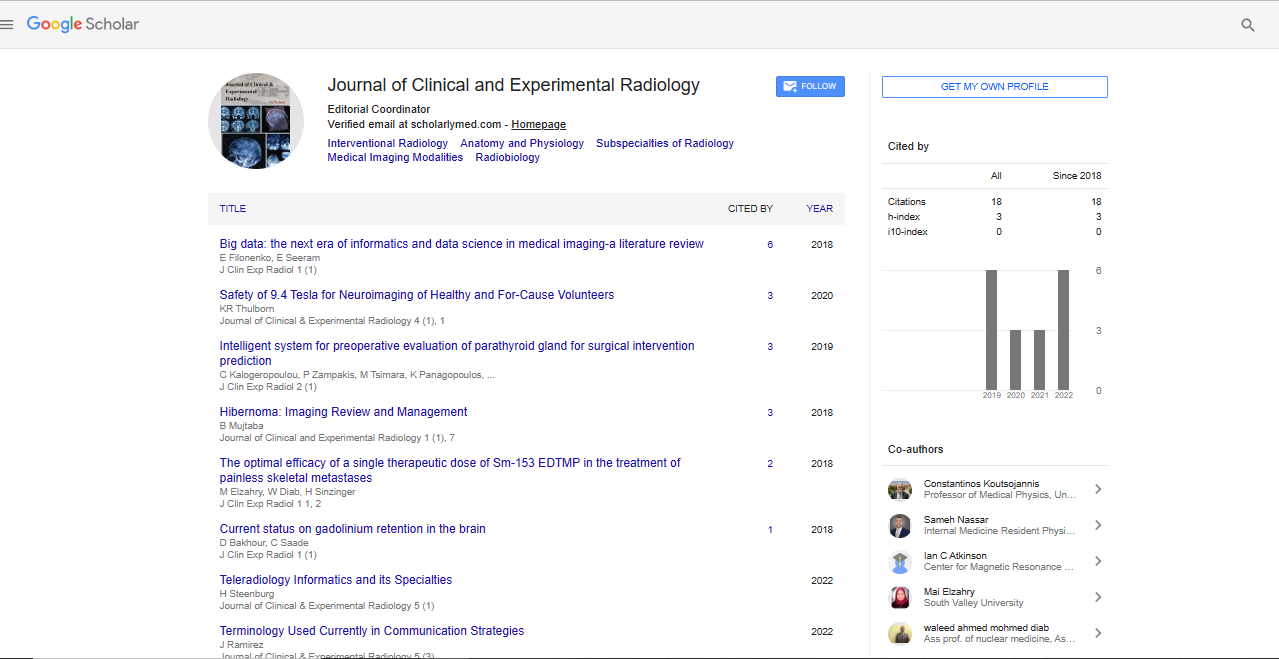Perspective, J Clin Exp Radiol Vol: 6 Issue: 1
Angiogram in Radiology: Procedure and Clinical Applications
Shady Ainley*Department of Radiology, University of Pisa, Pisa, Italy
*Corresponding Author: Shady Ainley
Department of Radiology
University of Pisa, Pisa, Italy
Email: ainleyshady@gmail.com
Received date: 20 February, 2023, Manuscript No. JCER-23-96003;
Editor assigned date: 22 February, 2023, PreQC No. JCER-23-96003(PQ);
Reviewed date: 08 March, 2023, QC No. JCER-23-96003;
Revised date: 15 March, 2023, Manuscript No. JCER-23-96003 (R);
Published date: 22 March, 2023, DOI: 10.4172/jcer.1000128
Citation: Ainley S (2023) Angiogram in Radiology: Procedure and Clinical Applications. J Clin Exp Radiol 6:1.
Description
Angiogram, also known as angiography or arteriography, is a common diagnostic imaging procedure used in radiology to visualize blood vessels in the body. It is a minimally invasive procedure that involves the injection of a contrast agent into the blood vessels, followed by the use of X-rays or other imaging modalities to provide detailed images of the blood vessels. Angiography plays an important role in the diagnosis and management of various vascular conditions, such as arterial blockages, aneurysms, and vascular malformations. In this article, we will explore the basics of angiogram in radiology, including the procedure, types of angiography, clinical applications, and potential risks.
Procedure of angiogram
Patient preparation: Before the angiogram, the patient may need to fast for a certain period of time and stop taking certain medications. The patient's medical history, including any allergies or previous adverse reactions to contrast agents, is reviewed. The patient is also informed about the procedure, its risks, and benefits.
Contrast agent injection: A contrast agent, which is a substance that enhances the visibility of blood vessels on X-ray or other imaging modalities, is injected into the blood vessels. The contrast agent is usually administered through a small catheter that is inserted into the blood vessel, either via a peripheral artery (e.g., in the arm or leg) or through a larger artery (e.g., in the groin or neck).
Imaging acquisition: Once the contrast agent is injected, X-ray or other imaging modalities, such as Computed Tomography (CT) or Magnetic Resonance Imaging (MRI), are used to capture images of the blood vessels. The contrast agent helps highlight the blood vessels and allows for the visualization of any abnormalities or blockages.
Image interpretation: The acquired images are reviewed and interpreted by a radiologist, who is a medical doctor specialized in interpreting medical images. The radiologist identifies any abnormalities, such as narrowed or blocked arteries, aneurysms, or vascular malformations, and provides a report to the referring physician.
Clinical applications of angiogram
Diagnosis of arterial blockages: Angiography is commonly used to diagnose arterial blockages, which can occur in various arteries throughout the body, such as in the coronary arteries of the heart, carotid arteries in the neck, renal arteries in the kidneys, and peripheral arteries in the arms and legs. Arterial blockages can cause symptoms such as chest pain, leg pain, and stroke, and angiography can help identify the location and severity of the blockage, guiding appropriate treatment decisions.
Evaluation of aneurysms: Angiography is also used to evaluate aneurysms, which are abnormal bulges or ballooning of blood vessels that can occur in various arteries, such as in the aorta, brain arteries, and peripheral arteries. Aneurysms can be life-threatening if they rupture, and angiography can provide detailed information about the size, shape, and location of the aneurysm, helping in the planning of treatment options, such as surgical repair or endovascular coiling.
Detection of vascular malformations: Angiography is a valuable tool in detecting and characterizing vascular malformations, which are abnormal connections between arteries and veins that can occur in various organs, such as the brain, liver, and lungs. Angiography can provide detailed images of the abnormal blood vessels and help in the planning of treatment options, such as embolization or surgical resection.
Pre-operative planning: Angiography is often used in preoperative planning for various vascular surgeries, such as bypass surgery or organ transplantation. It can provide detailed information about the anatomy and patency of blood vessels, helping surgeons plan the optimal surgical approach and reduce the risk of complications during surgery.
 Spanish
Spanish  Chinese
Chinese  Russian
Russian  German
German  French
French  Japanese
Japanese  Portuguese
Portuguese  Hindi
Hindi 